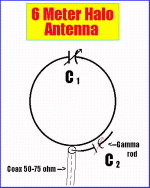kc5uta
Member
Exploring a new antenna project concept while redoing my shack. The Halo antenna. Pretty straightforard, its a halfwave antenna thats bent into a circle, with a gap between the ends. Gives it an omnidirectional pattern. BUT THAT is where it gets interesting. how to feed it? . Most are gamma match fed. Bolt it to the mast in the center of the half wave, add the gamma, or do the "squalo" thing and use a version of the hairpin match. Then there is ANOTHER method. Speaker wire. Or if you want to oversimplify, parallel conductor wire with a constant separation. Maybe twin lead or ladder line???? I got this version from here The Hula Hoop Halo; a simple DIY antenna for 6 meter band DX Using this principle, I built a 2 meter version. Tuned easily to 144.5 mhz with a 50 ohm impedance with minimal pruning. (made sure to cut equal lengths off both sides). I then took the remainder of the 50 foot roll I was using and made another one. After a bit of trimming it tuned 17 meters. My question is .....has anybody tried this concept with 160, or 80 meters etc..? And if so, how well did it perform in your opinion? I plan on building a version for 160, 80, 40 in my pasture at approx 30 feet up, in roughly a diamond shape, or mayb a hexagon. Anybody ever try this???





